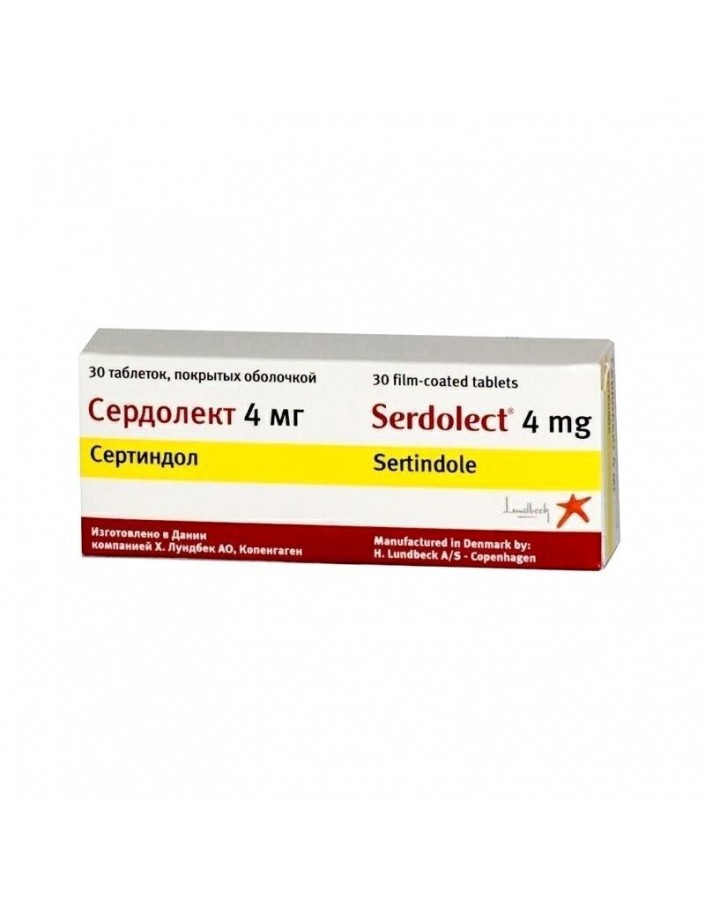




Security policy (edit with Customer reassurance module)

Delivery policy (edit with Customer reassurance module)

Return policy (edit with Customer reassurance module)
Antipsychotic, atypical neuroleptic, phenylindole derivative. It has an antipsychotic effect due to selective blockade of mesolimbic dopaminergic neurons and a balanced inhibitory effect on central dopamine D2receptors and serotonin 5HT2receptors, as well as on α1-adrenoreceptors.
Sertindol does not affect muscarinic and histamine H1-receptors, as evidenced by the lack of anticholinergic and sedative effects associated with effects on these receptors. Does not affect the level of prolactin.
After oral administration, sertindol is well absorbed from the gastrointestinal tract. Cmax in blood plasma is reached 10 hours after ingestion. Plasma protein binding - 99.5%. Metabolized in the liver with the participation of CYP2D6 and CYP3A isoenzymes. Metabolites do not possess neuroleptic activity. T1/2 is about 3 days.
Sertindol and its metabolites are excreted mainly with feces and partially with urine.
Schizophrenia (with the exception of acute psychotic disorders), with intolerance to at least one antipsychotic.
Is ingested 1 time / day.
The initial dose is 4 mg / day.Depending on the individual reaction, the dose can be gradually increased to 20 mg / day. If you exceed the dose of 20 mg / day, the risk of increasing the length of the QT interval increases significantly.
In patients with mild or moderate liver failure, as well as in elderly patients, sertindol should be used in low doses and a slower dose increase should be performed.
Respiratory: often - rhinitis, difficulty in nasal breathing; rarely - shortness of breath.
Nervous system: rarely - dizziness, paresthesia, syncopal states, convulsive disorders, motor disorders (including tardive dyskinesia), neuroleptic malignant syndrome.
Gastrointestinal: rarely, dry mouth.
Cardiovascular: rarely - postural hypotension, an increase in the QT interval, paroxysm of ventricular arrhythmias (such as "pirouette").
Urogenital: rarely - leukocyturia, hematuria.
Metabolism: rarely - weight gain, hyperglycemia.
Other: peripheral edema, decrease in ejaculate volume.
Hypokalemia, hypomagnesemia; severe cardiovascular diseases (including history), including congestive heart failure, myocardial hypertrophy, arrhythmia or bradycardia (less than 50 beats / min), congenital long QT syndrome, or the presence of this syndrome in relatives of the patient, acquired elongated QT interval (more than 450 msec for men and 470 msec for women); simultaneous medication,prolonged QT interval (including class I A and III antiarrhythmics, some antipsychotics, macrolide antibiotics, fluoroquinolones, antihistamines, cisapride, lithium preparations); simultaneous administration of drugs inhibiting CYP3A isoenzymes (including antifungal agents derived from azole, macrolide antibiotics, HIV protease inhibitors, cimetidine); severe liver failure; depression of the central nervous system function of various etiologies; pregnancy, lactation; children and adolescents up to 18 years; hypersensitivity to sertindole.
Use during pregnancy and lactation
Contraindicated in pregnancy, during lactation.
Application for violations of the liver
Contraindicated in severe liver failure. In patients with mild or moderate hepatic impairment, low doses should be used and a slower dose increase should be carried out.
Contraindicated in children and adolescents under 18 years of age.
With caution used in elderly patients.
It is used with caution in patients with epilepsy, Parkinson's disease, in liver failure, in elderly patients.
It is not recommended to use in emergency cases for relief of acute psychotic disorders.
When taking a number of drugs, prolongation of the QT interval is associated with the development of paroxysms of ventricular tachycardia (such as "pirouette")
Because of the potential danger of lengthening the QT interval, sertindole should be used in cases where there is already intolerance to at least one antipsychotic drug.
ECG monitoring should be carried out before the start of treatment, when the equilibrium concentration is reached (approximately 3 weeks after the start of administration) or when the dose reaches 16 mg / day. During maintenance therapy, an ECG study should be carried out before and after changing the dose of sertindole or after adding / increasing the dose of the drug, which can increase the concentration of sertindole in the blood plasma. At increase in an interval of QT more than 500 ms sertindol should be canceled.
Blood pressure monitoring is necessary during the dose titration period and at the beginning of the maintenance therapy period.
When symptoms appear on the background of treatment indicating the possibility of arrhythmia (including heartbeat, convulsions, syncope), the patient should be examined immediately, including an ECG.
Before starting the use of Sertindole, correction of hypokalemia and hypomagnesemia should be carried out. When vomiting, diarrhea, against the background of the use of diuretics, which can cause hypokalemia, with electrolyte disorders it is recommended to monitor the concentration of potassium in the blood.
With a slight or moderate degree of abnormal liver function, careful monitoring of the patient’s clinical condition is necessary.
With prolonged use of antipsychotic drugs, especially in high doses, the risk of tardive dyskinesia increases.If symptoms of tardive dyskinesia or neuroleptic malignant sertindol syndrome occur, it should be discontinued.
The safety and effectiveness of Sertindol in children and adolescents under the age of 18 years has not been established.
Influence on ability to drive motor transport and control mechanisms
Driving a motor vehicle and engaging in other potentially hazardous activities before determining the patient’s individual response to treatment is not recommended.
With simultaneous use with drugs that increase the QT interval, the risk of this effect increases.
Since sertindole is metabolized with the participation of CYP2D6 and CYP3A isoenzymes, while increasing with the inhibitors of the CYP2D6 isoenzyme (including Fluoxetine, paroxetine, quinidine), sertindole concentration in the blood plasma may increase. Sertindol and its main metabolites are weak inhibitors of the activity of the CYP2D6 isoenzyme, with the participation of which beta-blockers, antiarrhythmics, some antihypertensive drugs, many antipsychotic drugs and antidepressants are metabolized.
CYP3A isoenzyme inhibitors (including cimetidine, antifungal agents, pyrrole derivatives, HIV protease inhibitors, macrolide antibiotics) can significantly increase sertindole concentration in the blood plasma.
Under the influence of Carbamazepine, phenytoin, a significant acceleration of sertindole metabolism is possible, which leads to a decrease in its concentration in the blood plasma and a decrease in the antipsychotic action.